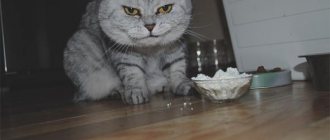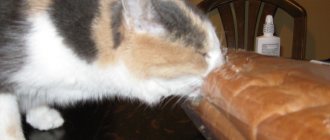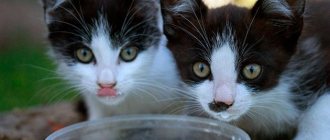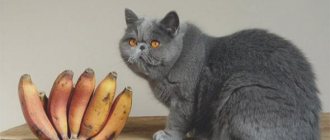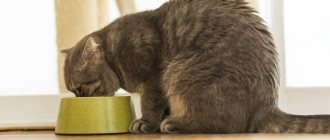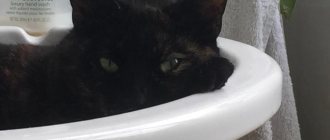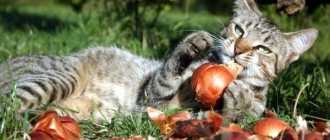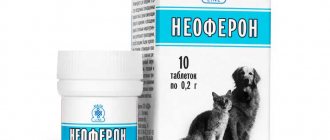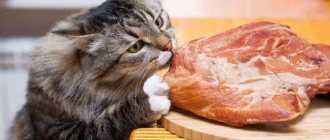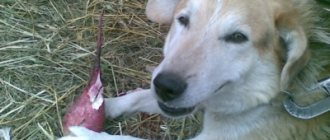Recently, the phrase “a cat is an obligate predator” has often been heard. And it is true. Cats are not omnivores. But if you think that a predator needs to be fed meat, then you are deeply mistaken. Eating pure meat leads to serious health problems due to an imbalance of minerals, primarily calcium and phosphorus, and a lack of vitamins. Meat is an excellent source of complete protein, but otherwise it has a poor composition. Therefore, offal for cats is not a delicacy or pampering, but a necessary component of the diet.
The secret to the survival and relative well-being of the wild ancestors of the domestic cat was eating the prey whole. Usually it is a small rodent or bird. In addition to meat, the cat receives bones and cartilage, fatty brain, stomach and intestines with all contents, liver, kidneys, lungs - in other words, all internal organs.
Cats eat whole mice
Feeding offal in addition to muscle meat allows you to balance the cat’s diet without numerous vitamin and mineral supplements. Another advantage is that by using different by-products, you can easily play with the calorie content, reducing or increasing the nutritional value depending on the pet’s needs.
At the same time, you need to carefully feed the internal organs of various animals to your cat, taking some precautions. In the article I will talk about what by-products to give to your pet and in what quantity, so that the benefits from them outweigh the possible negative consequences. Author of the article: Olga Shiltsova, practicing veterinarian, author of the books “Dachshund of Fate” and “Tails of Fortune”
How often to give your cat by-products, and in what quantity?
The share of by-products in the diet is calculated depending on their type. Muscular organs - the tongue, heart, gizzard of the bird - are given as part of the “meat” part of the diet, the total share of which is about 70%.
Internal organs (liver, kidneys, lungs, brains, spleen) provide 10-15% of the total diet. Another 10% should come from bones. Their sources are rabbit or poultry ribs, chicken necks and heads, and quail frames. The share of meat and bone ingredients is about 20%.
Chicken neck for a cat
If the cat has not eaten offal before, it needs to be introduced to it gradually, starting with microscopic quantities. When switching from dry food to natural food, the cat is first fed muscle meat, and then they begin to give various by-products, monitoring the pet’s individual reaction.
A variety of by-products is good for your pet
Muscle by-products can be fed to your cat daily, and some are fed 1-3 times a week to add variety to the diet. If, in response to feeding the internal organs, the cat's stool becomes thinner, their quantity is sharply reduced and the digestive tract begins to re-acclimate, gradually increasing the volume to the desired level.
Next, we will take a closer look at some types of by-products and their optimal quantity.
Honey for cats: can it be given, benefits and harms
Cats are fluffy pets that everyone has known since childhood. They differ in character, breed and color. Initially, the cat is a predator, feeding mainly on food of animal origin. But, as has been repeatedly noted, furry pets can often chew grass, or even house plants.
This happens because the body also requires plant fiber. Therefore, cats will take advantage of what is at hand (paw), to the displeasure of their owners, nibbling house flowers and plants.
The benefits of honey
It is quite difficult to overestimate the benefits of this natural product. In the numerous cat foods produced by humans, one can find seemingly all the necessary elements.
The main difference between honey is that it is not produced by humans, and this is its main benefit. Honey contains a large number of vitamins, a complex of minerals, and active biological compounds.
All this makes honey an indispensable product, not only for humans, but also for animals. The body absorbs this product one hundred percent!
Honey is used to prevent many diseases, and due to its pleasant taste, it is also used in cooking. There is only one limitation in the use of this amazingly useful product - dosage. Like other useful products, honey can be harmful only if consumed indefinitely.
As already mentioned, excessive consumption of honey can have a detrimental effect on the health of your animal. In such cases, the liver suffers greatly, especially in older individuals.
Also, you should not force your cat to eat honey. Animals, unlike people, live only by instincts, and are well aware of how their body works.
You should think about taking honey if your pet feasts on grass or flower inflorescences on the street. This means that the cat’s body does not have enough nutrients.
Note that the correct, safe dosage of honey for a cat is 1-2 teaspoons per day .
Choosing the “right honey”
The familiar character from the famous cartoon Winnie the Pooh correctly noted that the “wrong” bees have the “wrong” honey. In fact, there are many unscrupulous sellers who, for the sake of profit, dilute the product with sugar, starch, syrups... In general, who has enough imagination for what.
Let’s define for ourselves what “wrong honey” is, and how not to fall for the bait of dishonest traders:
- Smell . If you notice a sour aroma emanating from the product, then the honey may have fermented due to improper storage.
- Foam . The presence of foam and air bubbles on honey is also an indicator of a violation of the product storage rules.
- Color . The overly snow-white and dark-brown shade of honey hints at the presence of various impurities.
- Consistency . Too thin honey is an immature product containing a lot of water. It will not be able to be stored for a long time, as it will ferment. Ideally, honey should wrap around the spoon and fall down in thin, interrupted threads.
- The containers in which honey is sold should under no circumstances be metal. Ceramics, wood, glass - please, but not metal. Such honey is filled with heavy metal compounds and can even lead to poisoning. Eating it is dangerous to health.
Sellers have the ability to persuade the buyer. The main question you are interested in, after checking all the basic qualities of honey, you need to ask: “Where was this honey collected?”
Moreover, the definition of honey as mountain or lowland will not be an indicator of quality. It seems like the mountain one is better and cleaner. This is a stereotype that needs to get rid of.
The quality of the product will be influenced solely by the environment, in the place where the honey was collected. Plants growing near industrial plants or along polluted highways will be a harmful base for honey.
We can only hope for an honest answer from the seller and believe that he does not sell “industrial” honey.
Decent sellers are confident in themselves and their product. They will not jump around you and persuade you to buy products. Such people have regular customers and are very persistent.
When they offer you a product to try, they won't tell you exactly how to do it.
You, in turn, do not be shy and lower the spoon to the bottom of the mold, then take it out and watch how the honey slowly flows down in interrupted lines.
Honey should be stored at a temperature not exceeding 20°C . Because at high temperatures it quickly deteriorates and delaminates. Low humidity and dark dishes are also the best factors for preserving the product.
As already mentioned, honey should not be stored in metal products. Honey should not be stored together with other strong-smelling products, as there is a high probability of absorbing pungent odors.
And of course, if your pet loves honey very much, store it in places inaccessible to animals.
Choose and use the right honey for yourself and your pets!
Source: https://kotkoshka.ru/med-dlya-koshek-mozhno-li-davat-polza-i-vred/
By-products for cats are the only source of calcium
The most common mistake in natural feeding of cats is a violation of the ratio of calcium and phosphorus in food. For adult animals, the Ca:P balance should be approximately 1.2-1.7:1, for kittens 2:1. At the same time, most products, including meat, contain much more phosphorus than calcium.
The only chance to enrich the natural diet with calcium is to feed your pet not only meat, but also bones. To do this, chicken necks and heads are introduced into the diet.
Chicken heads: Cat's dinner can look creepy
Depending on the size and habits of the cat, chicken necks give:
- Entirely;
- Cut into pieces;
- Scrolled through a meat grinder as part of a meat mix.
Whole, sliced and twisted chicken necks
The hard and sharp beak is cut off from the chicken heads, and the heads themselves can first be beaten with a hammer.
Rules for feeding cats with bone by-products:
- Bones are given ONLY IN RAW FORM. Boiled bones are dangerous for cats.
- Bones should make up about 10% of the diet, which means 20-30% meat and bone ingredients.
- If the cat's feces become dry, white, or bowel movements are irregular (constipation), bones are excluded from the diet or their quantity is reduced.
- They only give spongy bones, not tubular bones (legs and wings are not allowed).
If you are afraid to give your cat bones or she cannot eat them for health reasons (diseases of the gastrointestinal tract, lack of teeth, etc.), calcium should be added to the diet in the form of commercial veterinary supplements.
Why honey attracts cats
Not all cats prefer to see exclusively familiar food in their diet. Many owners notice that their pets are partial to sweets, in particular honey. If milk is considered a very popular treat among cats, then the addiction to honey looks unusual from the outside. In fact, giving honey to a cat is quite natural and the animal’s craving for such products is not accidental.
© shutterstock
In their natural habitat, cats can eat bee products and they do not cause any harm to them. You yourself may notice that during a walk your pet is able to treat himself to the flowers of various plants. At such moments, pets have a need for flower pollen, which contains useful elements. Guided by its natural instincts, the cat wants to eat those foods that it lacks.
Domestic cats, who do not have the opportunity to go outside during the day, look for the necessary vitamins and minerals in food products familiar to people. So, if your cat loved honey for a certain period of time, and then began to eat it less actively, it is quite possible that at that time her body was weakened and needed to strengthen her immune system.
You can detect a tendency towards honey, as a plant fiber, in pets who love to feast on house flowers and this often spoils the mood of their owners. Your pet will be happy to receive apples with honey as a treat and will stop spoiling the plants.
It's a completely different matter if your cat has a real sweet tooth. The following factors may indicate this: :
- A cat can eat an unlimited amount of honey;
- The addiction to honey persists for a long time;
- In addition to honey, the cat also likes other sweets.
If your pet fits this description, it should not be given complete freedom of action and should be limited in its consumption of such products. A strict dosage of honey for a cat is necessary, since otherwise, the pet will have to be treated for unpleasant consequences in the future.
How honey can be dangerous for cats and the recommended dosage of the product
Having dealt with the question of why cats sometimes like to treat themselves to honey, you need to find out what the consequences of overeating this product can be. It's no secret that cats need to be fed in a balanced manner and an excess of any product in the diet will not benefit the animal. In the case of honey, excessive consumption can harm your pet's health.
© shutterstock
To be absorbed in the body, honey requires a lot of energy and, as a result, puts a lot of stress on the liver. If you have a young cat, the effect of stress on the liver may not be noticeable. As for older cats, for them too much honey can lead to very dangerous consequences. Thus, it is difficult to find a definite answer to the question of whether cat honey is harmful. It all depends on how much you give it to your pet and on the individual characteristics of your animal. No matter how much your pet loves honey, the recommended dose for a healthy pet is a maximum of 1-2 teaspoons per day.
By-products to increase calorie intake
Some parts of the carcass contain woefully little protein but are high in fat. And some, such as testes, are a source of protein and fat at the same time. Fatty by-products should not be given to cats with impaired liver or pancreas function, as well as animals prone to obesity. But they serve as an excellent energy boost, for example, for nursing cats or stud cats.
Testes (bovine, lamb)
Although the seeds are considered a delicacy in many cuisines around the world, they are quite difficult to find for sale. They don’t have to be included in your cat’s diet for it to be complete, but if the opportunity arises, be sure to let your pet try them.
Beef testes
The testes contain a lot of protein and fat, B vitamins and microelements (zinc, manganese, copper, nickel).
There is no need to be afraid of the hormones supposedly contained in the testicles. Their concentration in the testes is negligible, since all produced testosterone immediately enters the blood.
The testes are given raw or lightly boiled (7 minutes after boiling). Before giving them to a cat, remove the thick shell from the testicles and cut them into pieces. The norm is 5-10% of the diet, while it is permissible to feed the testes in a separate feeding, without mixing them with meat.
Beef udder
Udder is a cheap and nutritious product, but I recommend feeding it to cats with caution. The dry udder consists mainly of fat and rough connective tissue, which is difficult to digest. The milk udder has a more delicate consistency and a pleasant sweetish milky smell and taste. But cows are rarely slaughtered for meat during lactation without a good reason; usually these are sick animals. Therefore, the milk udder must be carefully checked for signs of mastitis (pus, inflamed areas).
The udder contains about 12% incomplete protein and 14% fat. It is given to cats in order to increase the calorie content of the diet, in an amount of no more than 5% of the total diet. This product is fed both raw and cooked (the broth after cooking is not used for feeding). The udder has a rubbery consistency, it is very difficult to chew or bite off a piece, so you need to cut it into convenient pieces in advance. The easiest way to cut a frozen product is to use a very sharp knife.
Brain
Beef brains can be difficult to find commercially because they are perishable. But if you give your cat chicken heads, then when she eats them, she also gets brains. The value of brains lies in the fats they contain. These are omega fatty acids, lecithins and cholesterol. The brain also contains a lot of choline (B4).
Beef brains, if you were able to buy them, are not fed in their pure form, but are added to the meat mixture. The high fat content of this offal causes severe diarrhea in cats if the dosage is overdone. Brains are given in the amount of 2% of the total diet. They can be especially useful for cats exhausted by pregnancy and lactation, as they increase the calorie content of food.
Human medicines for animals - which ones are possible and which ones are not
It has long been known that many people treat cancers with drugs intended for animals.
There are very good reviews about this treatment among patients, although doctors do not officially recognize this type of treatment.
But what about animals? Can they be helped in severe cases using medicines for humans? Which human medications can be given to animals and which cannot?
What human drugs will be effective in treating animals?
Alas, at the moment in Russia the development of medicines for animals is proceeding at a slow pace. And in those cases, even if they exist, it is not always possible to purchase them, for example, for residents of villages and hamlets.
In such cases, there is nothing left to do but look for a human drug that will help your beloved pet, but which drugs can be taken and which are strictly contraindicated? In fact, there are many medications that can help cure an animal.
The list of them is huge and each of them has been tested more than once and has proven its effectiveness:
- Duphalac. Helps cope with constipation, besides, it comes in the form of syrup and can be poured into the animal’s mouth using a syringe without any problems.
- Lactusan. This is another good drug, harmless to the animal and solves constipation problems in a short time. It also copes well with dysbiosis. If a pet is given an antibiotic, then this drug is given together with it until the course of treatment ends, and maybe even a little longer, in order to restore the intestinal microflora.
- Zantac and Quatemal are two drugs included in the group of gastroprotectors. They help protect the gastric mucosa, heal ulcers and erosions.
- Canephron. This is a herbal preparation that serves as an excellent remedy for the prevention of urolithiasis. I also recommend taking it to animals with kidney failure.
- Hofitol. It is also allowed to be taken to treat animals with renal failure and urolithiasis.
- Chlorhexidine. Copes well with various types of skin diseases. This drug is considered one of the most powerful antiseptics. Apply it to damaged areas of the skin and be sure to ensure that the animal does not spread it onto the mucous membranes; this is very dangerous.
- Ringer. This drug in the form of a solution is an excellent way to maintain the vital functions of an animal when dehydrated.
- Tetracycline ointment will perfectly help solve problems with eye diseases. It is simply placed behind the animal’s lower eyelid and after a few days you can forget about the disease.
- Insulin. Great for helping animals with diabetes.
- Sulphocamphocaine. An excellent remedy for cardiogenic and anaphylactic shock, chronic respiratory and heart failure, depressed breathing due to pneumonia and other infectious diseases.
- Allohol. It is recommended to give to animals with hepatitis, cholangitis, cholecystitis, constipation.
- Heptral. Recommended for liver and kidney pathologies.
- Bifidumbacterin. An excellent drug that helps restore intestinal microflora.
- Mildronad. Will help animals with various heart diseases.
- Dexamethasone. It is used for various pathologies, including eye injuries.
- Essentiale. Helps restore liver function.
- Mezim. Regulates the activity of the pancreas, gall bladder, and liver.
- Actoverin. Restores metabolic disorders of cerebral vessels.
- Cyanocobbalamin. And in general, this drug should always be present in the farmer’s medicine cabinet, as it helps solve numerous health-related problems in the animal: liver cirrhosis, hepatitis, polyneuritis, radiculitis, myelosis, neuralgia, multiple sclerosis, peripheral nerve injuries, skin diseases.
This list is not complete; there are many other drugs that will help alleviate the suffering of the animal. So, for example, you should never give aspirin to cats when they are hot, but antipyrine in this case will be an excellent remedy. In addition, it is also an excellent anti-inflammatory and analgesic.
But in addition to approved drugs, there are many that can cause serious harm to the animal’s health, so before giving the drug to your pet, you should definitely consult a veterinarian. It is also worth remembering that the human dose is not at all suitable for an animal, so you should definitely check this issue with a veterinarian, or it would be better to visit a veterinary clinic.
What human medications are contraindicated in animals?
Every resident of a remote village has more than once encountered the problem of an animal getting sick and not being able to find a veterinarian. That is why they often look at what is in their first aid kit to help their pet.
The list of approved drugs is described above, but there are those that, on the contrary, will aggravate his already poor health. Most human medicines contain substances that can lead to the death of the animal, for this reason you should not self-medicate.
The following drugs are especially dangerous for animals:
- Iodine. Who would have thought that such a completely safe drug for humans could cause serious harm to animals. It can not only burn the skin, but also lead to anaphylaxis.
- Vitamins. Who would have thought that simple vitamins could have a detrimental effect on the health of an animal? The animal’s body does not absorb them, and the sweet shell can cause allergies.
- Aspirin. It perfectly helps people reduce high fever, but in animals it can cause blood clotting disorders, which often leads to intestinal bleeding.
- Paracetamol and many other antipyretics can cause serious harm to the kidneys and liver.
- No-shpa. This is especially true for the solution; it can lead to immobilization of the hind limbs and also cause vomiting.
- Sedatives. Very often, in order to calm a cat, people give them valerian, the animal very quickly gets used to it, and in the future this can result in aggressive behavior of their beloved pet. In addition, they have a detrimental effect on the functioning of the heart.
- Sleeping pills can lead to coma.
- Imodium. A popular remedy for diarrhea, it helps people very well, but is contraindicated for animals. For many dogs it is not effective at all, and in others it can cause central nervous system damage or even death.
- Preparations containing diclofenac are strictly prohibited for animals.
- Isoniazid. Even one tablet can cause the painful death of an animal.
It is also strictly prohibited to use drugs containing benzyl benzoate in the treatment of animals. Since these drugs can lead to complex poisoning.
Alas, it will not be possible to describe every single drug, since every year the list is growing at an incredible pace. Therefore, in order not to harm your beloved pet, you should not give him medications if you are not sure of its safety.
If you get a pet, then you should also take care of a veterinary clinic, which will advise you on all questions of interest and help you solve all problems with the animal’s health at any time.
It is also necessary to take care that the animal, while playfully, does not stumble upon the medications; they should be hidden away.
Source: https://www.medmoon.ru/medicina/preparati_givotnim.html
Lungs - is it worth giving them to a cat?
One of the most useless beef by-products is lung. It is made of connective tissue and is difficult for cats to digest. In many animals, eating “airy” offal causes vomiting. Therefore, it is given in small quantities and in combination with meat or other organs.
Beef lung
It is quite possible to create a complete diet without using lungs, but if the cat likes their taste, they are fed in a volume of 5-15% of the diet. The peculiarity of this by-product is its low calorie content, which can be useful when preparing a diet for overweight animals.
If you cut the lung into small pieces and dry it in the oven, you will get an excellent delicacy. It is given to cats between main feedings.
How to choose the right honey
The benefits of cheese, honey and other natural products are difficult to overestimate, since they contain so many nutrients. The main benefit of honey is that it is not produced by humans and provides the body with many more vitamins and minerals than most chemical additives. Thus, honey is practically irreplaceable in the human diet. This product can also be beneficial to the cat's body, however, in moderation.
To avoid poisoning, do not force honey on your cat. Animals, in accordance with their natural instincts, independently determine what is missing in their body. You can give cats honey according to the recommended dosage if they eat plant inflorescences outside or at home.
If a product such as honey appears in your pet’s diet, you should approach its choice very carefully. It is important to use only high-quality honey, which will truly benefit your pet’s body.
Pay attention to the following factors when choosing honey
:
- Presence of a sour odor;
- Presence of foam and bubbles;
- Storage in metal containers.
All this indicates that honey is not stored correctly. Be careful and take care of your pets.
For cat owners, the thought sometimes comes to mind, “Will my cat catch a cold?” and “can I get a cold virus from my cat?”
The answer to the second question is unequivocal - no, you cannot get the cold virus from cats. Cold viruses are unique to each mammal. It’s easier for you and me to get a cold because we can see a doctor at any time and use various medications. Our cats do not have such opportunities, so a cold is a serious test for a cat. The signs of the disease in a cat are very similar to those in humans, such as sneezing, sniffles, coughing, wheezing, red eyes and even herpes around the mouth. Interestingly, cats are more likely to catch cold viruses in the summer.
Where can a cat catch a cold?
A cat can catch the virus at home, on the street and in a veterinary clinic. Absolutely everywhere. In the case of a home, the cause may be drafts; on the street, a cat can catch the virus from other cats.
How can you help your cat recover?
First of all, you don’t need to try feeding your pet various human medications and pills. Typically, a cat's cold lasts 7-10 days and she will be able to overcome the illness on her own at the end of the illness, but if you are very worried, you can call a veterinarian. A cold for a cat can be a very serious problem if the infection has penetrated into the lungs and bronchi. This is unpleasant because even after recovery, respiratory tract infections will occur again and again, after each cold. An important thing for cats is the smell of their food. They sniff food before eating. This is normal behavior for a cat, but if she has a cold and her nose is blocked, she will no longer be able to smell food for a while.
There is a good folk remedy - warm milk, but only with honey. Dissolve half a teaspoon of natural honey in warm milk. Almost all cats readily lap up this medicine, so there should be no problems with this treatment. There is, however, one “but” - the cat may be allergic to honey.
Therefore, before you start actively feeding your cat milk and honey, check to see if she is allergic to honey. If the cat does not begin to itch after the first dose of the “medicine” for a few hours, then treatment can be continued.
Two or three bowls of milk and honey will significantly improve your pet's condition.
What happens when a cat can't smell its food?
A cat with a stuffy nose will neither eat nor drink. Her body at this time may become dehydrated and begins to use up its own energy reserves. A bad result of this can be liver disease, which is life-threatening for your pet. Therefore, it is necessary to call a veterinarian the first time a cat with a cold refuses food and water. Vaccinations and vaccines against viruses can help prevent colds in cats. To prevent the disease, get vaccinated in a timely manner, after consulting with your veterinarian.
A bad sign, for a fight, quarrel.
Kittens - to profit.
Caressing a cat means mistrust, doubt.
A cat comes towards you, crosses the road - to a meeting with an enemy, an insincere person.
A caressing cat is unfortunately in the cat's owner's house.
A cat meows hysterically - a request for help that is difficult to fulfill.
Hearing a cat's meow means receiving hypocritical assurances of love.
Hearing a cat meow without seeing it is a sign of deception.
A cat bit you or scratched you - slander or insult of its owners against you.
A cat has bitten or scratched someone - to a slight discomfort, to your resentment towards this person.
Catching a cat means opening up gossip.
Cat games - to troubles in your personal life, identifying enemies.
A cat fight means worries.
Playing with a cat in a dream means infidelity.
A black cat means evil from an unknown enemy.
A dead cat means the disappearance of a person you dislike.
To see a strangled cat - your lifestyle will lead to bad consequences.
Causing harm or pain to a cat means having a bad conscience.
A man dreamed of a cat - some girl was “hunting” him.
A woman dreamed of a cat - signifies the emergence of a strong rival.
A cat catching a mouse means big profits and wealth.
Interpretation of dreams from the Dream Book of the 21st century
Subscribe to the Dream Interpretation channel!
Subscribe to the Dream Interpretation channel!
Is milk with honey or dry food good for cats?
When choosing the type of feeding for small animals, the question arises whether it is possible to feed kittens milk with dry food. When choosing a power type, there are three options. The first is a number of natural products, such as porridge with meat broth. The second is exclusively purchased dry food and canned food. And the third is mixed, when you alternate between porridge or canned food at different meals. The only condition is that you cannot give food and milk at the same time.
You can place a small saucer next to the bowl and pour the cow product into it. The kitten will lap up the tasty liquid whenever it wants. Milk is chosen from low-fat varieties, from 2 to 4%. It is not recommended to feed with cream or sour cream.
If a kitten is weaned from its mother too early, they should be given sweetened milk. Goat is best suited for this. Experienced veterinarians recommend adding glucose per glass of liquid and 1 teaspoon of sweetener. But you can’t add honey, because it causes allergies in pets and can lead to hair loss and constant itching of the skin. You should give milk to British Fold kittens with caution. If after a small amount of liquid, the stool remains the same, then the reaction is negative, and you can continue to give it little by little.
The cat is one of the most difficult symbols that one has to deal with when deciphering dreams.
The thing is that the image of a cat can appear in a dream for many reasons, and it is almost never possible to determine exactly how our subconscious worked at the moment when we saw a small kitten, a Siamese cat or an affectionate cat.
Perhaps in reality we encountered an amazing person who, despite all the difficulties, managed to avoid a seemingly imminent danger. After all, looking at precisely such people, we remember the folk wisdom: “He falls on his feet like a cat.”
The appearance of a cat in a dream can also be facilitated by meeting an independent, independent and slightly frivolous woman. And this is no coincidence, because in real life we call such a woman “a cat that walks on its own.”
Or perhaps the image of a cat in a dream arose as a result of the fact that memories of how the cat washed itself were deposited in our subconscious: the folk sign “The cat washes its face for guests” is no secret to anyone.
A cat can appear in a dream even when we are watching with pleasure how a young guy caresses and plays with a cat: after all, it’s rare that another folk wisdom does not come to mind at this moment: “He who loves cats will love his wife.”
What if we dreamed of a cat, as a warning of impending danger (after all, during the day we were very worried when a black cat crossed our path)?
As for those human qualities that characterize a cat, they are, without a doubt, known to everyone. This is cunning, deceit and malice.
But at the same time, we must not forget that in ancient times cats were deified and considered special animals. This means that any dream in which you saw a cat is prophetic. The most important thing is to be able to decipher it correctly.
Watching a cat wash itself in a dream means guests. It is possible that you will meet old good friends with whom you will have a great time.
Watching a dog hunt a cat in a dream is a warning that you should under no circumstances deceive your friends. Having learned about your deception, your friends will turn away from you forever.
Seeing in a dream a small kitten hiding in a tree from an angry dog is a sign that in real life you should be very careful.
If you dreamed of a kitten who, having noticed a dog in the distance, immediately runs to hide on the roof, then you should beware of a danger that you have already managed to avoid once.
If in a dream you saw a cat hunting for mice, then in the near future your life will be hectic and not entirely joyful. Various problems will arise on your way due to the deceit and evil machinations of your secret enemy.
If a cat scratched you in a dream, then in reality big problems await you, about which you will be very worried.
If you dreamed that a cat drove its claws right into your chest, then emotional anguish, sadness and sorrow await you.
Watching a cat pretending to be dead and lying next to a mouse hole means that in the near future someone close to you will attempt to deceive you.
Watching in a dream how a cat caught a mouse and carried it off to show its prey to other cats is a sign that in real life you are a very vain person.
Perhaps such a dream indicates that there are vain people around you who will bring you great misfortune.
If in a dream a black cat crossed your path, then in reality you should beware of dangers. Such a dream also suggests that you overestimate your strength, and therefore you should not refuse the help of friends.
Seeing a cat with kittens in a dream means problems with children. Perhaps your child is deceiving you.
Petting a cat sitting on your lap in a dream is a sign that in your environment there is a not entirely decent, frivolous woman who will greatly let you down by taking advantage of your trust.
Watching a young guy or a single man stroking a cat in a dream means that when he gets married, he will love his wife very much.
Feeding a cat in a dream is a sign that it’s time to stop “soaring in the clouds” and mind your own business.
Watching several cats fighting in a dream is evidence that a streak of minor setbacks awaits you, so be patient and courageous.
If in a dream an unfamiliar cat caresses you, it means that one of your new acquaintances has decided to take advantage of your kindness and trust. Be careful.
Seeing a dead cat in a dream is a bad omen. Apparently, you will learn about the illness of someone close to you.
Interpretation of dreams from the Ancient Dream Book
Subscribe to the Dream Interpretation channel!
Subscribe to the Dream Interpretation channel!
Subscribe to the Dream Interpretation channel!
Many pet owners are wondering whether cats can eat honey, since this delicacy is often enjoyed by pets, but is known to be an allergic product. Cats and dogs often have unusual tastes and prefer chocolate or honey to salty treats. However, a person should be very careful when giving such products to their pet.

